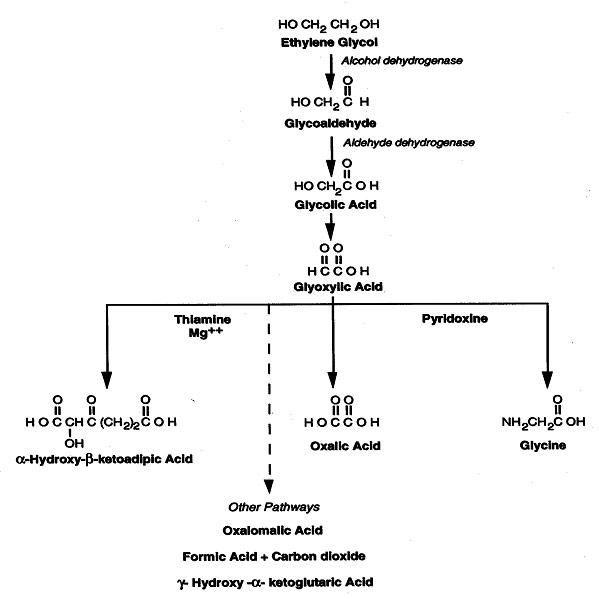What Is the Biological Fate of Ethylene Glycol?
Course: WB 4342
CE Original Date: March 20, 2020
CE Renewal Date: March 20, 2022
CE Expiration Date: March 20, 2024
Download Printer-Friendly version [PDF – 954 KB]
Ethylene glycol is rapidly absorbed from the gastrointestinal tract and slowly absorbed through the skin or lungs. It is distributed throughout total body water. Most of an absorbed dose of ethylene glycol is metabolized by the liver and a small portion is excreted unchanged in the urine.
Ethylene glycol is rapidly absorbed from the gastrointestinal tract and slowly absorbed through the skin or lungs. Studies involving animals fed single doses of ethylene glycol by gavage show that absorption is rapid and nearly complete. Peak plasma concentrations occurred in 1–4 hours, increasing linearly with dose among various species (i.e., rats, mice, monkeys). (International Programme on Chemical Safety 2002).
Because it is highly water-soluble, ethylene glycol is distributed throughout total body water. The normal serum half-life of ethylene glycol is estimated at about 2.5 hours in children and 3–8 hours in untreated adults (Eder et al. 1998).
The parent compound ethylene glycol has relatively low toxicity other than its inebriating effects. The liver metabolizes ethylene glycol by successive oxidations to a variety of compounds that include
- glycoaldehyde
- glycolic acid
- glyoxylic acid, and
- oxalic acid
These compounds are more toxic than ethylene glycol itself (Figure 1)
The rate-limiting step in this metabolic process is the conversion of ethylene glycol to glycoaldehyde, a process catalyzed by alcohol dehydrogenase (ADH).
Several factors might influence susceptibility to ethylene glycol-induced toxicity, including the following:
- Individual differences in ADH activity
- Nutritional deficiencies, notably lack of thiamine or pyridoxine (two vitamins that mediate the metabolic detoxification of ethylene glycol)
Concomitant ethanol exposure can decrease or prevent toxicity by preferentially competing for ADH, thereby inhibiting transformation of ethylene glycol to glycoaldehyde.

Figure 1. Metabolism of ethylene glycol. Adapted from (Hall AH 1992).
If the patient is free of ethanol exposure, the liver metabolizes approximately 80% of an absorbed dose of ethylene glycol [Brent 2001].
A small fraction of ethylene glycol (less than 20% after low-dose ingestion) passes unchanged in the urine.
The breakdown of ethylene glycol metabolites can generate CO2, which is eliminated through the lungs (ATSDR 2010).
- Ethylene glycol is rapidly absorbed from the gastrointestinal tract and slowly absorbed through the skin or lungs.
- Ethylene glycol is metabolized in the liver to a variety of more toxic compounds.
- In untreated adults, approximately 20% of a dose of ethylene glycol is excreted unchanged by the kidneys.
- The half-life of ethylene glycol in untreated adult patients is 3–8 hours.
To review relevant content, see “Metabolic Pathway” and “Elimination” in this section.